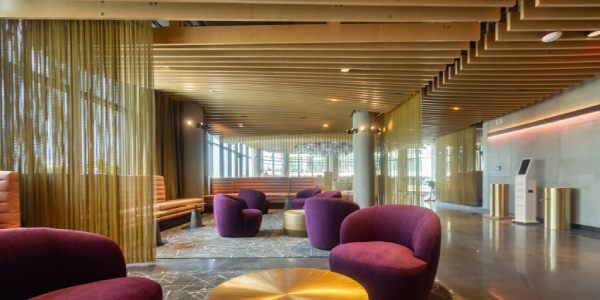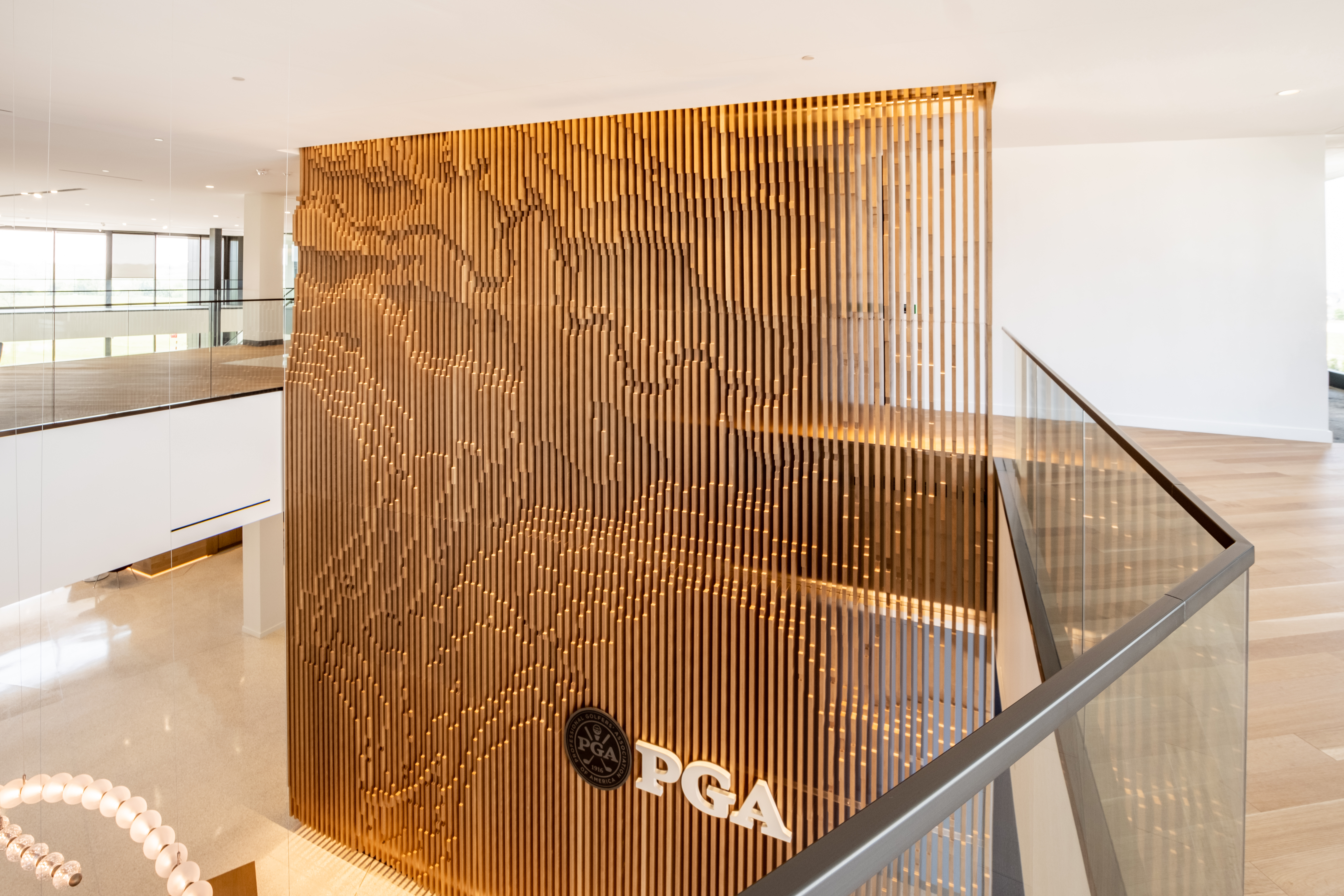Sustainable Materials in Modern Interiors: A Practical Guide for Designers

Quick Summary: The Fundamentals
The construction industry accounts for nearly 40% of global carbon emissions, making sustainable material choices essential. True sustainability considers the entire lifecycle: sourcing, manufacturing, transportation, installation, maintenance, and end-of-life. Key certifications include FSC (Forest Stewardship Council), LEED credits, HPDs (Health Product Declarations), and EPDs (Environmental Product Declarations). Sustainable materials must balance environmental responsibility with fire ratings, durability, maintenance requirements, and budget—and today's options deliver on all fronts without compromise.
Now let's dive into the specific sustainable options available for interior finishes and architectural features.
Sustainable Interior Wood Finishes: Your Specification Guide
FSC-Certified Solid Wood for Feature Walls
FSC-certified wood remains the gold standard for vertical slat walls, paneling, and architectural features. What many designers don't realize is that FSC certification is available for virtually any species—from domestic white oak and walnut to exotic veneers—without compromising aesthetics or lead time.
Application considerations:
- Vertical slat wall systems
- Architectural feature walls
- Acoustic wall installations
- Curved and geometric wall systems
- Branded environmental graphics integration
Performance notes: FSC certification contributes directly to LEED v4 MR credits (Materials and Resources). Request chain-of-custody documentation from your fabricator to ensure the certification carries through to your project.
Engineered Wood Products: Baltic Birch Plywood
Baltic birch plywood represents one of the most efficient uses of forest resources for interior applications. Sourced from sustainably managed forests in Northern Europe, this material uses smaller, faster-growing trees and utilizes nearly the entire log through its layered construction.
Why specify Baltic birch:
- Exceptional dimensional stability (critical for large-scale installations)
- Consistent quality and predictable performance
- Low-VOC adhesives in modern manufacturing
- Cost-effective for projects requiring volume
- Beautiful exposed edge detail when left natural or edge-banded
Best applications:
- Vertical slat wall systems (0.75" or 1.5" thickness)
- Geometric pattern installations
- Corporate branding walls
- Feature wall installations
- Biophilic design elements
Baltic birch accepts stains, clear coats, and pigmented finishes beautifully. When finished with low-VOC, water-based coatings, it contributes to improved indoor air quality while maintaining durability.
Reclaimed Wood: Authenticity with Environmental Impact
Reclaimed wood offers unmatched sustainability by repurposing material from deconstructed barns, factories, and warehouses. Beyond the environmental benefits, reclaimed wood brings irreplaceable character—weathering, patina, nail holes, and grain patterns that tell a story.
Specification considerations:
- Requires experienced fabrication partner for inspection and preparation
- Inconsistent dimensions and hidden hardware must be addressed
- Limited availability may affect lead times for large projects
- Premium pricing reflects labor-intensive preparation
Ideal projects:
- Hospitality and experiential spaces
- Feature walls and accent installations
- Corporate environments emphasizing authenticity
- Branded environments with heritage storytelling
Reclaimed wood has already proven its durability by surviving decades (or centuries) in its original application. This makes it exceptionally reliable for high-traffic commercial environments.
Reconstituted Veneer: The Sustainable Alternative You Should Specify
Reconstituted veneer (also called engineered veneer or recomposed veneer) is one of the most underutilized sustainable materials in architectural woodwork. Here's why it deserves serious consideration.
What Is Reconstituted Veneer?
Reconstituted veneer is manufactured by laminating thin layers of fast-growing, sustainably harvested wood species (often poplar or tropical plantation woods) and then slicing them to create veneer sheets. The result is a product that mimics the appearance of rare or slow-growing hardwoods without depleting those resources.

Environmental Advantages
Resource efficiency: Reconstituted veneer uses fast-growing species that reach maturity in 5-10 years, compared to 50-100+ years for traditional hardwoods like walnut or mahogany.
Consistency and yield: Because the material is engineered, there's virtually no waste from defects, knots, or irregular grain. A single log produces significantly more usable veneer than traditional slicing methods.
Reduced pressure on endangered species: Reconstituted veneer can replicate the appearance of rare woods without harvesting them, protecting biodiversity.
Certifications available: Many reconstituted veneers carry FSC certification and can contribute to LEED credits.
Design and Performance Benefits:
Consistency: Unlike natural veneer, which varies from sheet to sheet, reconstituted veneer offers uniform color and grain patterns across large installations. This is invaluable for feature walls spanning multiple panels.
Customization: Manufacturers can create custom colors, grain patterns, and even entirely unique aesthetics not found in nature.
Stability: The engineered structure provides excellent dimensional stability, reducing warping and movement in varying humidity conditions.
Cost-effectiveness: Reconstituted veneer typically costs 30-50% less than rare natural veneers while delivering a similar aesthetic.
Best Applications for Reconstituted Veneer:
- Large-scale wall or ceiling systems
- Corporate and commercial interiors
- Hospitality and public space installations
- Transportation and aviation interiors
- LEED-certified projects with budget considerations
What to Ask Your Fabricator
- Can you provide FSC-certified reconstituted veneer options?
- What substrate options work best with reconstituted veneer? (MDF, plywood, etc.)
- What finish options enhance the veneer's appearance and durability?
- Can you provide samples showing the consistency across multiple sheets?
Reconstituted veneer is particularly effective when you need the look of high-end wood without the environmental impact or cost. It's a smart specification choice for designers who understand that sustainability and aesthetics aren't mutually exclusive.

Fire-Rated Sustainable Materials: Meeting Code Without Compromise
One of the biggest concerns with sustainable wood materials is fire safety. Here's how to meet code requirements while maintaining your commitment to sustainability.
Understanding ASTM E84 (Flame Spread)
- Class A: Flame spread 0-25 (corridors, exit stairs, high-occupancy spaces)
- Class B: Flame spread 26-75 (general commercial interiors)
- Class C: Flame spread 76-200 (limited applications, typically requires sprinklers)
Natural Baltic birch typically rates Class C (FSI ~120). Most office spaces with sprinkler systems accept Class C materials, but verify with your local code official.
Sustainable Fire-Rating Solutions
Fire-retardant treatments: Wood can be pressure-treated or coated with fire retardants to achieve Class A ratings. Request ASTM E84 test reports and verify that the treatment doesn't void FSC certification.
Fire-rated engineered products: Medite FR and similar fire-rated MDF products use inherently fire-resistant materials rather than chemical treatments. These products maintain FSC certification and achieve Class A ratings.
Intumescent coatings: These coatings expand when exposed to heat, creating an insulating barrier. They can be applied to finished wood surfaces and are available in low-VOC formulations.
Critical Documentation to Request:
- ASTM E84 test reports for the specific product and finish
- Verification that installation method doesn't void fire rating
- Confirmation that certifications (FSC, low-VOC) remain valid after fire treatment
Specifying Sustainable Materials: Questions for Your Fabricator
Not all fabricators can deliver on sustainability promises. Here's what to ask:
Sourcing and Certifications
- Where do you source materials, and can you provide FSC chain-of-custody certification?
- Do you offer EPDs (Environmental Product Declarations) and HPDs (Health Product Declarations)?
- Can you provide ASTM E84 fire test reports for sustainable materials?
Manufacturing Practices
- What waste reduction practices do you employ? (CNC optimization, scrap recycling, etc.)
- What finish options are available in low-VOC or water-based formulations?
- How do you handle quality control for reclaimed or reconstituted materials?
Project-Specific Support
- Can you provide samples that include sustainable material options?
- Will you maintain duplicate samples for custom finishes to ensure consistency?
- Can you assist with LEED documentation and submittal requirements?
A fabricator who answers these questions confidently, and provides documentation to back it up is a true partner in sustainable design.
